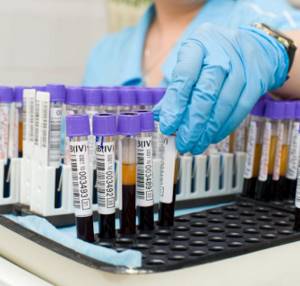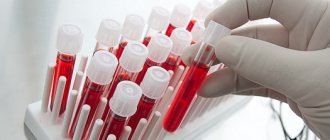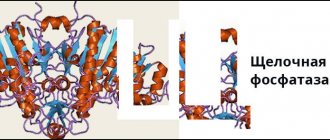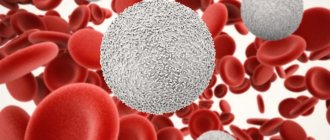November 18, 2015
What does a biochemical blood test say about enzymes and the vital functions of our body?
So, in the previous article we found out that using a biochemical blood test you can find out about everything that is happening in the body. Well, let’s open our book at the chapter “Enzymes”. They are dissolved in the blood in minute concentrations, but why can determining their level sometimes be decisive in making a diagnosis? In general, what are they and what role do they play? Let's figure it out.
Enzymes (enzymes) are substances of protein nature that accelerate the course of certain metabolic reactions in the body tens or even hundreds of times.
Not a single reaction can occur without enzymes. Moreover, each enzyme is capable of acting on only one single target, that is, this group of substances is characterized by high specificity. It also works only under certain conditions (acidic/alkaline environment, high/low temperature). Each enzyme consists of a so-called protein base (apoenzyme) and an active center (coenzyme), which can have a different structure (ion, high/low molecular weight component). Actually, it is the active center that catalyzes the reaction.
Since the substance is very specific, then, of course, each enzyme has its own substrate, which fits it like a lock to a key. By joining the substrate, the enzyme undergoes an active reaction, after which a product is ultimately formed from the substrate, which has completely different properties and is necessary for the body for any subsequent reactions.
Now imagine that every minute millions of biochemical interactions occur in your body... And enzymes are involved in all of them.
There are enzymes that are characteristic of all types of cells and catalyze reactions common to all of them. And there are enzymes that can be found in greatest quantities only in certain cells of certain organs. They are of diagnostic value, and, therefore, we will deal with them. In the first part of our "book of enzymes" we will talk about transaminases - a separate and very characteristic group of enzymes.
Why does the doctor refer for a biochemical blood test?
A detailed study of the biochemical composition of the blood provides high accuracy in monitoring the condition of the body. Therefore, it is used not only for diagnosis, but also for monitoring the healing process for quick correction of treatment tactics.
The most revealing results of the study are the discovery of:
- problems of the hepatobiliary apparatus;
- renal dysfunction;
- disorders of hormonal secretion;
- heart disease and hematopoiesis;
- diseases of the locomotor system;
- digestive pathologies.
The benefits of biochemical analysis of blood components are valued in diagnosing various types of anemia, infectious pathologies, for detecting inflammation, allergies, and coagulopathies.
How is blood drawn?
Following the recommendations of doctors when preparing to take blood for analysis will ensure maximum accuracy of the indicators and facilitate diagnosis. In order not to distort the indicators, the patient needs:
- Avoid eating, drinking sugar-sweetened drinks, and smoking 8 hours before your venous puncture. It is advisable to use only clean water during this period of time, so the test is most often carried out in the morning.
- Avoid consuming alcoholic beverages, vitamin complexes and other dietary supplements, herbal (strengthening or medicinal) teas 2 days before the procedure. You should tell your doctor if you are taking any medications, as test results may change under the influence of some medications.
- 24 hours before donating blood, limit physical activity and avoid going to the bathhouse or sauna. You should avoid stress and remain calm the entire day before the examination.
Venous blood is used to assess the biochemical composition. The most common place for sampling is the elbow bend. But if taking biomaterial from the ulnar vessels is impossible, it is permissible to use other veins.
The future puncture site must be thoroughly treated with an antiseptic. Only 5-10 ml of blood is enough to take the necessary measurements.
Blood plasma (serum) enzymes
Enzymes that are normally found in plasma or serum can be divided into 3 groups: secretory, indicator and excretory. Secretory enzymes, synthesized in the liver, are normally released into the blood plasma, where they play a certain physiological role. Typical representatives of this group are enzymes involved in the process of blood clotting and serum cholinesterase. Indicator (cellular) enzymes enter the blood from tissues, where they perform certain intracellular functions. One of them is located mainly in the cytosol of the cell (LDH, aldolase), others - in mitochondria (glutamate dehydrogenase), others - in lysosomes (β-glucuronidase, acid phosphatase), etc. Most of the indicator enzymes in blood serum are normally detected only in trace amounts. When certain tissues are damaged, enzymes from the cells are “washed out” into the blood; their activity in serum increases sharply, being an indicator of the degree and depth of damage to these tissues.
Excretory enzymes are synthesized mainly in the liver (leucine aminopeptidase, alkaline phosphatase, etc.). Under physiological conditions, these enzymes are mainly excreted in bile. The mechanisms regulating the entry of these enzymes into bile capillaries have not yet been fully elucidated. In many pathological processes, the release of excretory enzymes with bile is disrupted, and the activity in the blood plasma increases.
Of particular clinical interest is the study of the activity of indicator enzymes in blood serum, since the appearance of a number of tissue enzymes in increased quantities in plasma or serum can indicate the functional state and damage to various organs (for example, the liver, cardiac and skeletal muscles). In acute myocardial infarction, it is especially important to study the activity of creatine kinase, AST, LDH and hydroxybutyrate dehydrogenase.
In case of liver diseases, in particular with viral hepatitis (Botkin's disease), the activity of ALT and AST, sorbitol dehydrogenase, glutamate dehydrogenase and some other enzymes in the blood serum significantly increases. Most of the enzymes contained in the liver are also present in other tissue organs. However, enzymes are known that are more or less specific for liver tissue. Such enzymes, in particular, include γ-glutamyl transpeptidase, or γ-glutamyl transferase (GGT). This enzyme is a highly sensitive indicator for liver diseases. An increase in GGT activity is observed in acute infectious or toxic hepatitis, liver cirrhosis, intrahepatic or extrahepatic blockage of the bile ducts, primary or metastatic tumor damage to the liver, and alcoholic liver damage. Sometimes an increase in GGT activity is observed with congestive heart failure, rarely - after myocardial infarction, with pancreatitis, pancreatic tumors.
Histidase, sorbitol dehydrogenase, arginase and ornithine carbamoyltransferase are also considered organ-specific enzymes A change in the activity of these enzymes in the blood serum indicates damage to the liver tissue.
Currently, the study of the activity of isoenzymes in blood serum, in particular LDH isoenzymes, has become a particularly important laboratory test. It is known that in the heart muscle the isoenzymes LDH1 and LDH2 are most active, and in the liver tissue – LDH4 and LDH5 (see Chapter 10). It has been established that in patients with acute myocardial infarction, the activity of the LDH1 and partly LDH2 isoenzymes sharply increases in the blood serum. The isoenzyme spectrum of LDH in the blood serum during myocardial infarction resembles the isoenzyme spectrum of the heart muscle. On the contrary, with parenchymal hepatitis in the blood serum the activity of isoenzymes LDH4 and LDH5 increases significantly and the activity of LDH1 and LDH2 decreases.
The study of the activity of creatine kinase isoenzymes in blood serum is also of diagnostic importance. There are at least 3 creatine kinase isoenzymes: BB, MM and MB. In brain tissue, the BB isoenzyme is mainly present (from the English brain - brain), in skeletal muscles - the MM form (from the English muscle - muscle). The heart contains a hybrid MV form as well as an MM form. Creatine kinase isoenzymes are especially important to study in acute myocardial infarction, since the MB form is found in significant quantities almost only in the heart muscle. An increase in the activity of the MV form in the blood serum indicates damage to the heart muscle.
The increase in the activity of serum enzymes in many pathological processes is explained primarily by two reasons: 1) the release of enzymes into the bloodstream from damaged areas of organs or tissues against the background of their ongoing biosynthesis in damaged tissues; 2) a simultaneous increase in the catalytic activity of some enzymes that pass into the blood. It is possible that an increase in enzyme activity during a “breakdown” of the mechanisms of intracellular regulation of metabolism is associated with the cessation of the action of the corresponding enzyme regulators and inhibitors, changes under the influence of various factors in the structure and structure of enzyme macromolecules.
Previous page | Next page
CONTENT
Decoding the results of a biochemical blood test
Measuring various blood parameters takes only a few hours, but the report is almost always given to the patient the next morning. The results should be assessed by a physician who is aware of the correspondence of characteristic disorders to specific diseases. Self-familiarization of the patient with the test results will allow one to notice the violation, but only a qualified doctor can diagnose the disease based on all available data.
When conducting analyses, the level of:
- proteins;
- fats;
- carbohydrates;
- a number of inorganic components and vitamins;
- nitrogenous substances;
- pigments;
- enzymes.
A change in each of the indicators indicates health problems.
Squirrels
During the analysis, the total amount of protein in the blood serum is calculated. Normally, for an adult man or woman this parameter is 60-85 g/l, while for a child it should remain within 47-75 g/l. Elevated protein signals a possible infection, rheumatoid arthritis, oncology, bleeding, as well as problems with the liver, pancreas, intestinal tract, and kidneys.
Lipids
The normal saturation of the bloodstream with fats is 4.5–7.0 g/l. Factors influencing increased fat levels include diabetes, hepatitis, excess weight or jaundice. In addition to the total saturation of blood with lipids, cholesterol levels are measured separately. Cholesterol going beyond the range of 3.0–6.0 mmol/l is often provoked by hypofunction of the thyroid gland, liver disease, alcoholism, atherosclerosis, and pregnancy. A drop below normal is caused by hyperthyroidism or a disorder of fat metabolism.
Carbohydrates
The main energy resource for the human body is carbohydrates, among which glucose occupies a key place. In the blood, its normal content is limited to 3.5–5.5 mmol/l. An increase in the indicator may result from:
- diabetes mellitus (DM);
- hypersecretion of thyroid hormones;
- pheochromocytomas;
- Cushing's syndrome;
- violations of renal and hepatic functions;
- physical or psychological stress;
- pancreatic dysfunction;
- acromegaly.
Low glucose is determined by a poor diet, excess insulin, pancreatic diseases, the presence of a tumor, and decreased activity of the endocrine system.
Inorganic blood components and vitamins
In diagnosing diseases, the main attention is paid to the level of:
- gland,
- potassium,
- calcium,
- sodium,
- chlorine,
- vitamins B9 and B12.
Their purpose is to stimulate metabolism and maintain water-salt balance.
Increased iron concentration is often accompanied by:
- some types of anemia (hemolytic, sickle cell, aplastic);
- leukemia;
- abuse of iron-containing dietary supplements.
A decrease in iron content in the bloodstream is distinguished by iron deficiency anemia, decreased secretion of thyroid hormones, oncology, and internal bleeding.
Excessive potassium levels are caused by:
- cell damage;
- dehydration;
- renal or adrenal insufficiency.
Low potassium is the result of prolonged fasting, lack of element in the diet, vomiting, diarrhea, excessive secretion of corticosteroid hormones, and kidney disease.
An increase in calcium concentration occurs due to:
- strengthening the work of the parathyroid gland;
- malignant neoplasm affecting the bones;
- sarcoidosis;
- excess vitamin D;
- dehydration.
A decrease in calcium is provoked by hypofunction of the thyroid gland, lack of vitamin D or magnesium, chronic renal impairment, and hypoalbuminemia.
An increase in sodium may be caused by:
- excess salt consumption;
- hypersecretion of the adrenal cortex;
- violation of the central mechanism for maintaining water and electrolyte balance.
A lack of sodium in the bloodstream will help diagnose kidney pathology, nephrotic syndrome, diabetes, liver cirrhosis, or diuretic overdose.
An increase in chlorine is often caused by:
- dehydration;
- acute kidney failure;
- diabetes insipidus;
- intoxication with salicylates;
- hyperfunction of the adrenal cortex.
A decrease in the indicator occurs with dehydration caused by:
- profuse sweating;
- vomiting;
- gastric lavage.
The main factors affecting the normal level of vitamins are an irrational diet and disturbances in the gastrointestinal tract, leading to the impossibility of their normal absorption.
Low molecular weight nitrogenous substances

Among the nitrogen-containing blood components, creatinine, uric acid, and urea most reflect the health status.
Until the age of 14, the level of urea and creatinine, normal for a child, is 1.8–6.4 and 27–62 mmol/l, respectively. In adults, their concentration gradually increases, determined mainly by the functioning of the urinary apparatus. An upward shift in the level of substances occurs due to renal dysfunction, blockage of the urinary ducts, and excess protein in the diet. An increase in concentration is also observed in burns and acute myocardial infarction. A decrease in indicators is the result of a lack of proteins in the diet, pregnancy, or impaired reabsorption.
Under normal conditions, uric acid in children under 14 years of age reaches a level of 120–320 µmol/l, and then rises to 150–350 µmol/l in women or 210–420 µmol/l in men. Exceeding the physiological threshold of a substance is facilitated by:
- gout;
- kidney diseases;
- multiple myeloma;
- toxicosis;
- wrong diet;
- excessive physical activity.
A decrease in the amount of uric acid is caused by Wilson-Konovalov disease, Fanconi syndrome, and a lack of nucleic acids in food.
Pigments
Calculating the amount of total and direct bilirubin resulting from the breakdown of copper or iron-containing proteins is also one of the tasks of a biochemical blood test. The normal limit for total bilirubin is considered to be 5–20 µmol/l. Its rise above 27 µmol/l is a symptom of Gospel disease, oncology, hepatitis and other liver pathologies, acute intoxication, cirrhosis, cholelithiasis, B12 deficiency.
The content of direct bilirubin should not exceed 0–3.4 µmol/l. Excess of a component beyond the physiological limits can be provoked by viral or toxic hepatitis, infectious liver disease, syphilis, inflammation of the gallbladder, jaundice in pregnant women or infantile hypothyroidism.
Enzymes
Normal secretion of enzymes is the key to healthy metabolism. Therefore, important indicators of health are the levels of aminotransferase circulating in the bloodstream (up to 34 U/L for women and up to 45 U/L for men), lactate dehydrogenase (140–350 U/L), and creatine phosphokinase (up to 200 U/L).
An upward shift in enzyme content causes:
- acute or chronic hepatitis;
- hepatic necrosis;
- myocardial infarction;
- inflammation of the heart muscle;
- extensive destruction of red blood cells;
- pulmonary embolism;
- diseases of skeletal muscles;
- bile stagnation;
- oxygen starvation;
- myositis;
- epilepsy.
The doctor makes a diagnosis based on changes in biochemical analysis in combination with the emerging symptoms of the disease.
Enzymes
Enzymes are specific proteins that act as biological catalysts in the body. Enzymes are found in all cells of the body, where their concentration is much higher than in blood plasma.
Normal levels of enzyme activity in serum reflect the relationship between the biosynthesis and release of enzymes, as well as their clearance from the bloodstream.
The study of enzyme levels in clinical practice is used to solve the following problems:
- establishing a diagnosis;
- carrying out differential diagnostics;
- assessment of the dynamics of the disease;
- determining the effectiveness of treatment and the degree of recovery.
The Clinical Diagnostic Laboratory determines the serum activity of the following enzymes:
Amylase
Amylase is an enzyme that breaks down polysaccharides. The pancreas and salivary glands are richest in this enzyme. Determination of amylase activity is important in the diagnosis of pancreatic diseases.
An increase in amylase activity in the blood serum by 2 or more times should be regarded as a symptom of damage to the pancreas. Determination of amylase activity in urine is more informative about the function of the pancreas.
Pancreatic amylase
Pancreatic amylase is a biologically active substance involved in the metabolism of carbohydrates. In the human body, most of it is produced by the pancreas.
In case of disease of the pancreas or blockage of the duct between it and the duodenum, pancreatic amylase begins to be released into the blood, indicating a significant problem in the condition of this important digestive organ.
Lipase
Lipase is a water-soluble enzyme that catalyzes the hydrolysis of insoluble ester-lipid substrates, helping to digest, dissolve and fractionate fats.
Lipase, together with bile, breaks down fats and fatty acids, as well as fat-soluble vitamins A, D, E, K, converting them into energy for heat production.
AST - aspartate aminotransferase
AST - aspartate aminotransferase - an enzyme widely distributed in human tissues (heart, liver, skeletal muscle, kidneys, lungs, etc.).
AST activity in the blood increases in a number of diseases, especially when organs and tissues rich in this enzyme are damaged.
The most dramatic changes in AST activity are observed when the heart muscle is damaged. AST also increases in acute hepatitis and other severe damage to liver cells.
ALT - alanine aminotransferase
ALT - alanine aminotransferase - an enzyme found in skeletal muscles, liver, and heart. In the myocardium it is significantly less than AST. ALT reaches its highest concentrations in the liver.
In clinical practice, simultaneous determination of AST and ALT activity in the blood is widely used; it carries much more information about the localization and depth of the lesion, the activity of the pathological process; allows you to predict the outcome of the disease.
ALP - Alkaline phosphatase
ALP - alkaline phosphatase - is widely distributed in human tissues, especially in the intestinal mucosa, osteoblasts, and the walls of the bile ducts of the liver. An increase in alkaline phosphatase activity accompanies rickets of any etiology and bone changes associated with hyperparathyroidism.
Enzyme activity rapidly increases in osteogenic sarcoma, cancer metastases in the bones, multiple myeloma, lymphogranulomatosis with bone damage.
A significant increase in alkaline phosphatase activity is observed in cholestasis. Its increase is observed in 90% of patients with primary liver cancer and with metastases to the liver. Its activity sharply increases in case of alcohol poisoning against the background of chronic alcoholism. It may increase with medications that exhibit a hepatotoxic effect.
GGT - gamma-glutamyl transpeptidase
GGT - gamma-glutamyl transpeptidase - is found in the liver, pancreas, and kidneys.
In other tissues - in small quantities. Changes in its activity in serum are of great diagnostic importance for diseases of the liver and hepatobiliary tract. This enzyme is more sensitive to disorders in liver cells than ALT, AST, alkaline phosphatase, etc.
LDH—total lactate dehydrogenase.
LDH - total lactate dehydrogenase - the highest activity is found in the kidneys, myocardium, skeletal muscle and liver. Under physiological conditions, increased LDH activity is observed in pregnant women and in individuals after intense physical activity.
Among the pathological conditions, increased LDH activity is caused by myocardial infarction, congestion in the liver, pulmonary infarction, myopathy, liver carcinoma or cancer metastases to the liver, megaloblastic and hemolytic anemia, acute and exacerbation of chronic kidney diseases.
Where is the best place to get a biochemical blood test?

It is possible to study the biochemical composition of blood in any clinic. In public medical institutions there are always huge queues, taking away several hours of free time.
It is much more convenient to go for testing to a private clinic. The cost of such a laboratory test is low, so everyone can afford to undergo an examination without wasting time in line and staying in a dull hospital environment. Medical is a modern clinic with its own laboratory, which is equipped to all medical standards. Here, any examination takes place quickly and in a pleasant atmosphere.
Preparing for a biochemical blood test and taking it
For analysis, blood is taken from a vein, usually in the area of the elbow joint. If there is no access to this place, then the analysis is taken from a vein in the area of the foot, leg or hand. The procedure is painless, but due to the nervous state the patient may feel unwell and even lose consciousness, so before donating blood it is recommended to calm down and set yourself in a positive mood.
Features of preparation for blood biochemistry:
- Blood is donated on an empty stomach. Taboo on alcohol and smoking.
- Before diagnosis, you should not overeat, the last meal should be taken no later than 8-9 pm, the food should be light and low-calorie. Sweets, coffee, and strong tea are excluded from the diet.
- It is not recommended to take a test after physiotherapy and x-ray diagnostics, therefore all medical procedures, as well as taking medications, should be carried out after donating blood.
If the medications cannot be stopped because there is a health risk, you must notify the doctor so that he understands what factors influenced the test results.
Cost of laboratory diagnostic services
The price of a biochemical blood test depends on the number of test indicators. Often, a doctor, when writing a referral for analysis, already has an assumption about the nature of the disease, so he suggests checking only enzymes, proteins or other blood components. It's inexpensive and doesn't take much time.
But if the patient needs to simultaneously check several indicators, it is better to do a full biochemical analysis. Although this procedure is more expensive, it allows you to assess the general condition of the body.
To make an appointment or find out the cost of laboratory diagnostics, call the phone numbers: +7 (495) 181-02-03 or. Medical professionals are always happy to help you improve your health.






